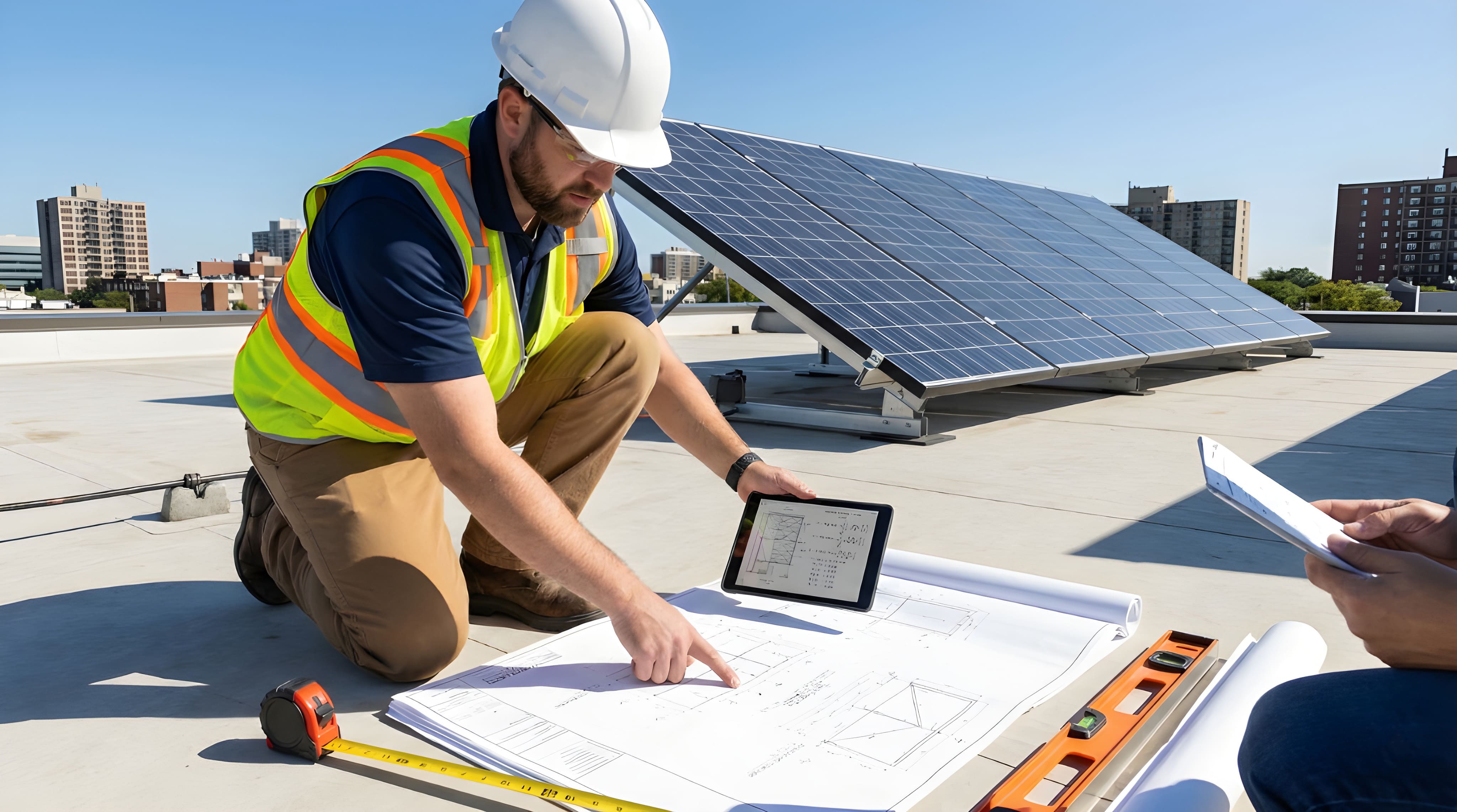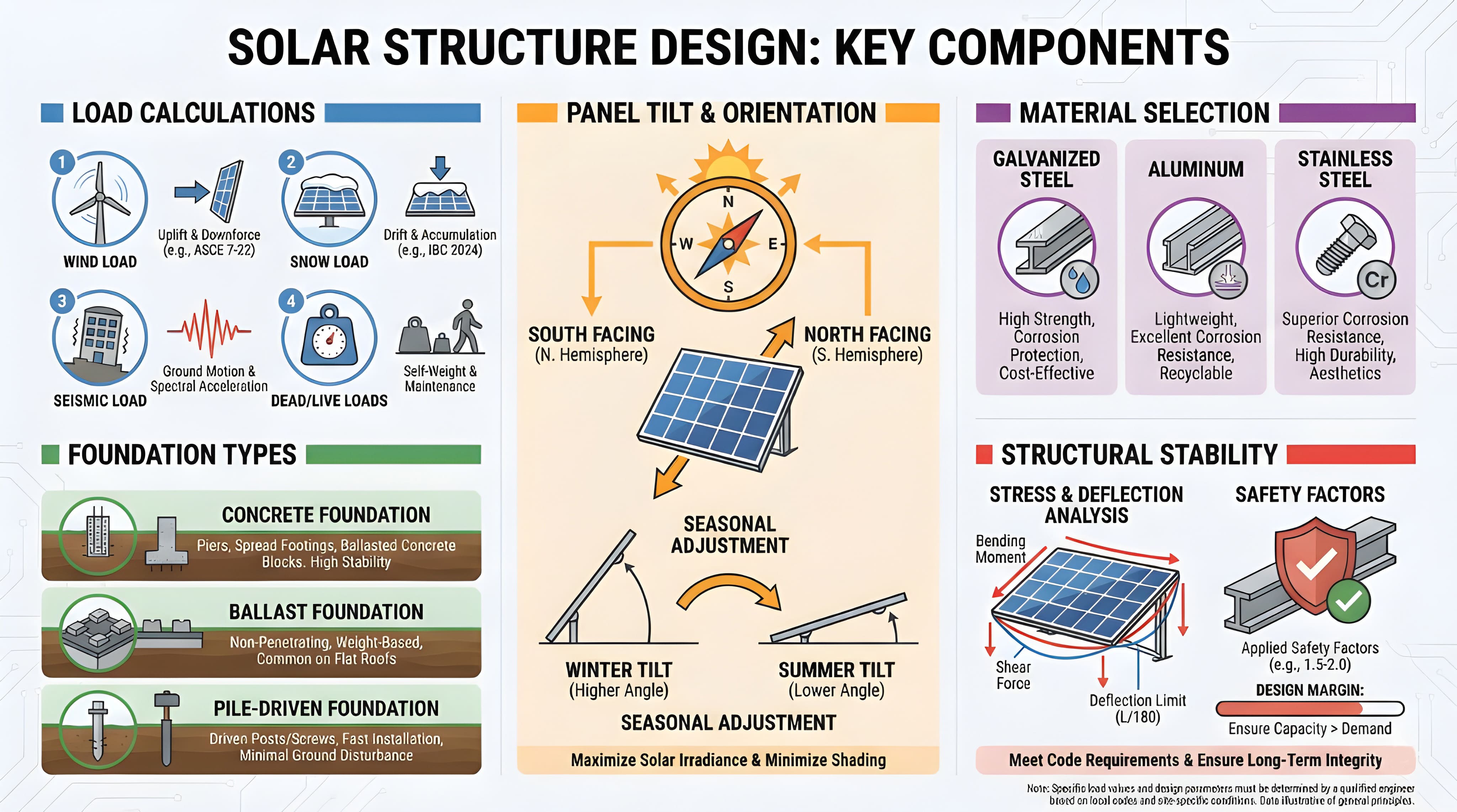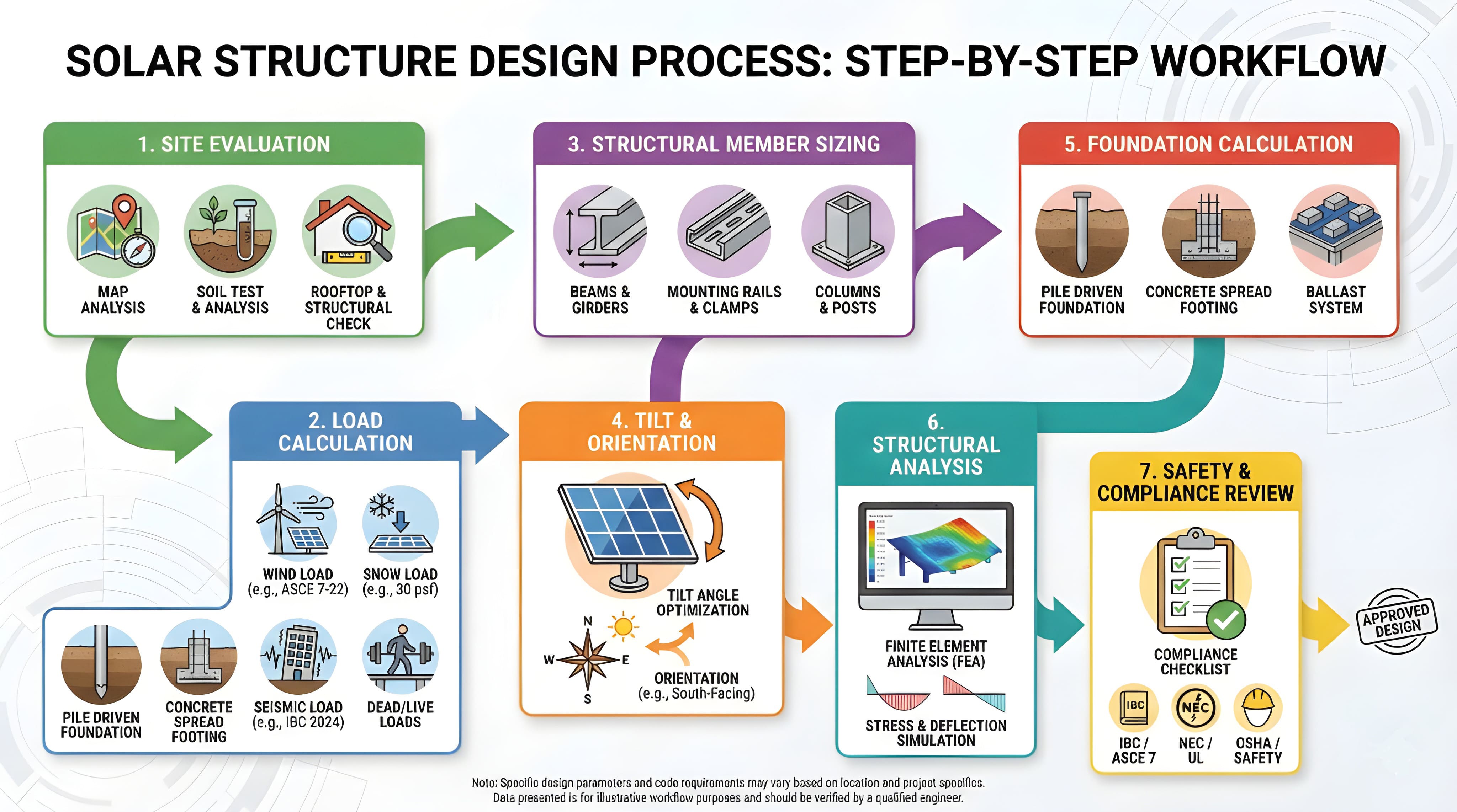

Solar structural engineering calculations are engineering computations that determine the specifications needed to build safe, durable solar mounting systems. These calculations analyze five critical load types: dead loads (panel and equipment weight), live loads (maintenance forces), wind loads (uplift and drag), snow loads (accumulation weight), and seismic loads (earthquake forces). The process ensures solar installations withstand environmental conditions while maintaining optimal energy production angles.
Solar structure design calculations are the technical process engineers use to specify requirements for solar mounting systems. The calculations determine three primary factors: structural strength (load-bearing capacity), dimensional sizing (beam, rail, and column specifications), and optimal positioning (tilt angle and orientation based on latitude). Engineers follow building codes such as ASCE 7 and IS 875 to calculate how structures will perform under combined loading scenarios including wind speeds up to design limits, snow accumulation, and seismic activity.
The calculation process involves seven sequential steps: site evaluation (collecting location data and soil properties), load calculation (quantifying all force types), structural member sizing (determining component dimensions), tilt and orientation optimization (setting panel angles), foundation calculation (designing anchoring systems), structural analysis (testing under simulated loads), and compliance verification (ensuring code adherence with safety factors of 1.5 to 2.0).
Accurate calculations prevent structural failures, extend system lifespan beyond 25 years, maximize energy efficiency through proper 10-degree seasonal tilt adjustments, balance costs by avoiding overdesign, and satisfy regulatory requirements. Material selection between galvanized steel, aluminum alloys, and stainless steel depends on corrosion resistance needs, while foundation types (concrete, ballast, or pile-driven) are determined by soil bearing capacity and wind load requirements.
Safety: Flawed calculations can lead to structural collapses that result in accidents or property damage.
Longevity: Accurate computations ensure the system withstands environmental pressures for decades.
Energy Optimization: Correct tilt and orientation maximize solar panel efficiency.
Economic Balance: Overdesigning increases costs unnecessarily, while underdesigning creates failure risks. Proper calculations ensure affordability.
Regulatory Adherence: Comprehensive structural design calculations are often mandated by engineering codes and renewable energy regulations.

Load calculation stands as one of the most vital aspects of solar structure design. Every solar mounting system must support multiple load categories, including seismic, wind, snow, dead, and live loads. Dead load encompasses the weight of solar panels, modules, and mounting hardware. Live load accounts for temporary forces such as workers, equipment, or maintenance activities. Wind load proves particularly critical in high wind velocity regions, as it generates uplift and drag forces on panels. Snow load applies in colder climates where snow accumulation adds substantial weight. In earthquake-prone areas, seismic load becomes significant, with both vertical and horizontal forces potentially affecting stability. Accurate calculation of these loads ensures the solar structure remains strong enough to handle environmental conditions without excessive overengineering that drives up costs.
The tilt angle and orientation of solar panels directly influence energy production in a solar power system. Tilt angle is typically determined based on the installation location's latitude to achieve optimal solar exposure year-round. Generally, the tilt angle should match the latitude, with minor seasonal adjustments achieved by adding 10 degrees in winter and subtracting 10 degrees in summer. Orientation refers to the compass direction panels face. For maximum performance, solar panels should face true south in the Northern Hemisphere and true north in the Southern Hemisphere. This component is critical in solar design because incorrect tilt and orientation can cause significant energy losses.
Choosing appropriate materials is crucial for creating solar structures that are both durable and cost effective. Most solar mounting systems utilize galvanized steel, aluminum alloys, or stainless steel. Galvanized steel is ideal for long-term outdoor installations due to its strength and corrosion resistance. Aluminum suits both rooftop and ground-mounted systems as it is lightweight, manageable, and rust-resistant. While more expensive, stainless steel provides exceptional durability in high-humidity environments or coastal areas where corrosion poses a major concern. The mechanical properties of materials, including yield strength, tensile strength, and environmental stress resistance, are carefully evaluated during solar structural calculations to ensure system longevity and reliability.
Foundation design serves as the cornerstone of any ground-mounted solar installation. Soil conditions, wind loads, and total system weight all influence foundation requirements. Foundations must anchor the solar system to prevent toppling or shifting under external forces. Common foundation types include concrete foundations for permanent ground-mount systems, ballast foundations for rooftops where penetration is prohibited, and pile-driven foundations for utility-scale solar farms. In colder climates, frost depth and soil bearing capacity determine the foundation's depth and dimensions. Without proper foundation calculations, even perfectly designed mounting structures can fail, making this a critical consideration during the design phase.
Structural stability results from precise design calculations and appropriate material selections. It ensures the solar mounting system remains secure and functional for decades, even when subjected to dynamic forces like wind, snow, and seismic activity. A stability check verifies that deflections, stresses, and moments in structural members stay within permissible limits. Engineers incorporate safety factors, typically ranging from 1.5 to 2.0, to account for unforeseen circumstances and uncertainties. Structural stability matters for both safety and maintaining optimal panel positioning, as even minor misalignments can reduce energy generation. This element guarantees the solar installation's reliability and long-term performance.

The design process begins with a site assessment to gather essential data including location coordinates, wind speed, seismic activity, and soil properties. For rooftop installations, factors such as load capacity, orientation, and slope are also evaluated. This information forms the foundation for accurate design calculations.
Engineers determine the various loads acting on the structure, including dead loads (weight of panels and equipment), live loads (temporary forces during maintenance), earthquake loads, wind loads, and snow loads. Standards such as IS 875 or ASCE 7 ensure accuracy and safety.
Beams, rails, and columns are sized according to the selected material, such as steel or aluminum, based on calculated loads. The goal is to ensure adequate strength without excessive overdesign that unnecessarily increases costs.
Panels are angled according to the location's latitude, with adjustments made for seasonal efficiency. Orientation is set to face either true south in the Northern Hemisphere or true north in the Southern Hemisphere to optimize solar exposure.
The foundation is designed to securely anchor the structure against seismic and wind forces. Its depth and type, such as pile-driven, concrete, or ballast, are determined based on soil bearing capacity and installation requirements.
Before finalization, the system undergoes structural analysis using software tools to test it under simulated loads. This confirms stresses, deflections, and stability, helping ensure the design meets performance standards.
Finally, the design is reviewed for conformity with relevant engineering codes, and safety factors are applied to address uncertainties. This phase ensures long-term durability, safety, and regulatory approval.
Accurate solar structural engineering calculations are non-negotiable for any solar installation project. These calculations determine whether a system will safely withstand decades of environmental exposure or fail prematurely, potentially causing property damage and safety hazards. From initial site assessment through final compliance verification, every calculation step builds upon the previous one to create a comprehensive structural solution. For expert guidance, consult with professional solar structural engineers.
The investment in proper structural engineering pays dividends through reduced maintenance costs, extended system lifespan, and optimized energy production. Whether designing a residential rooftop array or a commercial solar farm, adherence to established engineering standards and building codes protects both the investment and the people who interact with these systems. As solar technology continues advancing, the fundamental principles of structural integrity remain constant, making these calculations an indispensable part of the renewable energy transition.
What are the main loads considered in solar structure design calculations?
Solar structure design calculations must account for five primary load types: dead loads (permanent weight of panels and mounting equipment), live loads (temporary forces from maintenance workers and equipment), wind loads (uplift and drag forces from wind), snow loads (weight from snow accumulation in cold climates), and seismic loads (forces from earthquake activity in prone regions). Each load type requires specific calculation methods based on local conditions and building codes such as ASCE 7 or IS 875.
How is the optimal tilt angle for solar panels determined?
The optimal tilt angle is primarily determined by the installation location's latitude. As a general rule, the tilt angle should equal the latitude of the site. For seasonal optimization, engineers may add 10 degrees to the latitude for winter months to capture lower sun angles, or subtract 10 degrees for summer months when the sun is higher in the sky. This calculation ensures maximum solar exposure throughout the year while maintaining structural integrity.
What safety factors are typically used in solar structure design?
Engineers typically incorporate safety factors ranging from 1.5 to 2.0 in solar structure design calculations. These factors provide a buffer against unforeseen circumstances, material imperfections, calculation uncertainties, and extreme weather events that may exceed standard design parameters. The specific safety factor applied depends on the structural component, load type, material properties, and local building code requirements. This conservative approach ensures the system remains safe even under conditions beyond normal operating parameters.
Why is foundation design critical for ground-mounted solar installations?
Foundation design is critical because it anchors the entire solar array against environmental forces that could cause toppling, shifting, or structural failure. The foundation must be engineered based on soil bearing capacity, wind loads, seismic activity, and total system weight. In colder climates, frost depth becomes an additional factor to prevent foundation heaving. Without proper foundation calculations, even perfectly designed mounting structures can fail, making foundation engineering one of the most important aspects of solar installation safety and longevity.
What building codes and standards govern solar structure design?
Solar structure design is governed by several national and international building codes and standards. The most commonly referenced include the International Building Code (IBC), International Residential Code (IRC), and ASCE 7 which covers wind and seismic design requirements. In India, IS 875 provides load calculation standards. These codes ensure consistent safety standards across projects and jurisdictions. Engineers must stay current with code updates, as standards evolve to incorporate new research and improve solar installation safety.
Can existing rooftops always support solar panel installations without reinforcement?
Not all existing rooftops can support solar panel installations without structural reinforcement. The determination requires a comprehensive structural analysis that evaluates the roof's current load capacity, age, condition, and design. Many older buildings were not designed with the additional dead load of solar panels in mind. If the existing structure cannot safely support the added weight and environmental loads, reinforcement options may include adding support beams, strengthening connections, or upgrading structural members. A qualified structural engineer must perform these calculations before installation to ensure safety and code compliance. For additional resources on solar permitting and design, consult professional engineering services.
We are dedicated to providing top-notch solar permit services to homeowners, business owners, DIY, and solar installers. Contact us today.